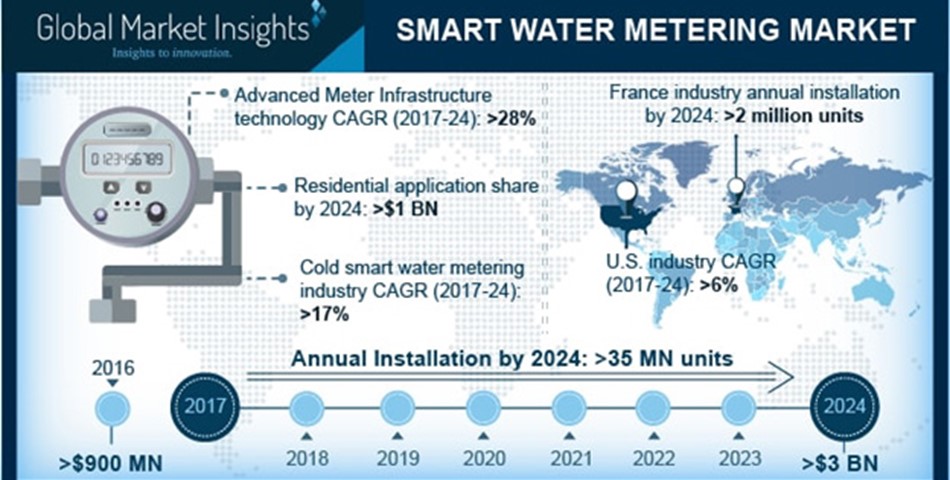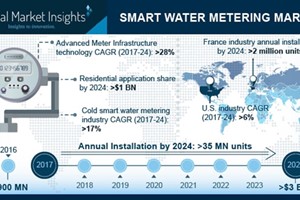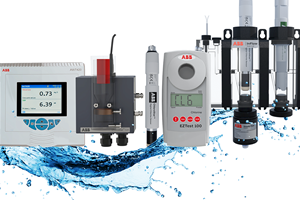Global Smart Water Metering Market is set to grow from its current market value of more than $900 million to over $3 billion by 2024; according to a new research report by Global Market Insights, Inc. Implementation of favorable government policies and rollout programs toward the adoption of intelligent systems will boost the smart water metering market. Initiatives focusing on effective water monitoring and conservation will further propel the industry landscape. For instance, the European Union in collaboration with the International Monetary Fund announced a mandatory rollout of smart water meters in Ireland.
Increasing measures toward water security and monitoring of Non-Revenue Water (NRW) will enhance the smart water metering market. Increasing urbanization, ageing distribution mains and rising energy cost will further provide a stimulus to the industry outlook. According to the World Bank, 32 billion cubic meters of treated water is lost through leakages in distribution network worldwide. An additional 16 billion cubic meters is supplied annually but not charged due to poor metering, inappropriate billing and thefts. U.S. smart water metering market is projected to expand over 6% by 2024. Ongoing water conservation reforms coupled with government funding toward installation of smart grid technologies will positively drive the product adoption. In 2013, the U.S. Department of Energy and the Smart Grid Investment Grant (SGIG) mutually sponsored the installation of smart grid infrastructure in the nation and provided a federal financial assistance of over USD 8 billion in 99 ventures. AMI smart water metering market is predicted to grow over 28% by 2024. The use of AMI systems is attributed to quick detection of water leakages, reduction in water wastage and improved water supply. These systems offer advanced capabilities in data analysis and operations. Growing measures toward effective mapping of water distribution coupled with regulatory regimes to limit non-revenue water loss will complement the Europe smart water metering market. Increasing administrative emphasis toward the development of high-performance advanced MAGNETIC FLOW METER Global Smart Water Metering Market is set to grow from its current market value of more than $900 million to over $3 billion by 2024; according to a new research report by Global Market Insights, Inc. Implementation of favorable government policies and rollout programs toward the adoption of intelligent systems will boost the smart water metering market. Initiatives focusing on effective water monitoring and conservation will further propel the industry landscape. For instance, the European Union in collaboration with the International Monetary Fund announced a mandatory rollout of smart water meters in Ireland. Smart water metering market infographic Water Metering | PUMPS & FLOW METERS 19 France Smart Water Metering Market Size, By Application, 2016 & 2024 (Million Units) www.gminsights.com systems will further embellish the industry growth. Ongoing technological advancement to develop effective and precise metering technologies will boost the commercial smart water metering market. Rising concerns relating to reduction of water wastage and water scarcity will further facilitate the product adoption. Notable players operating in the smart water metering market comprise of Landis+GYR, Badger Meter, Itron, Siemens, Arad Group, Schneider Electric, Sensus Sentec, Neptune, Kamstrup, Elster Group, Diehl Metering and Honeywell International. The smart electric segment is projected to have the largest share of the smart meters market during the forecast period The smart meters market is segmented, by type, into smart electric, smart gas, and smart water meters. The smart electric segment accounted for the largest market share in 2019, driven by the growing emphasis on dynamic pricing and integration of growing DER into the existing power system operations in regions such as North America, Europe, and Asia Pacific. The future growth of the segment can be attributed to increasing demand for highly accurate and precise measurement of utility consumption data for consumers across end-users such as residential, commercial, and industrial sectors. The cellular segment is expected to be the fastest growing market, by communication type, during the forecast period The communication type segment of the smart meters market is segmented into RF, PLC, and Cellular. Cellular expected to register the highest growth rate during the forecast period. The growth of the cellular communication type is attributed to the availability of robust telecommunication infrastructure for smart meter operations across regions such as Europe and North America. In addition, the use of cellular communication reduces the operational cost for utilities in implementing smart meter projects. The residential segment is expected to be the fastest-growing market segment in the smart meters industry, by end-user, during the forecast period. The smart meters market is segmented, by end-user, into residential, commercial, and industrial. The residential sector is projected to grow at the fastest rate during the forecast period. The increasing power consumption drives the smart meter growth rate in the sector among residential consumers due to technological and economic advancements and the growing government support for mandatory smart meter rollout projects in the sector.
https://www.gminsights.com/














